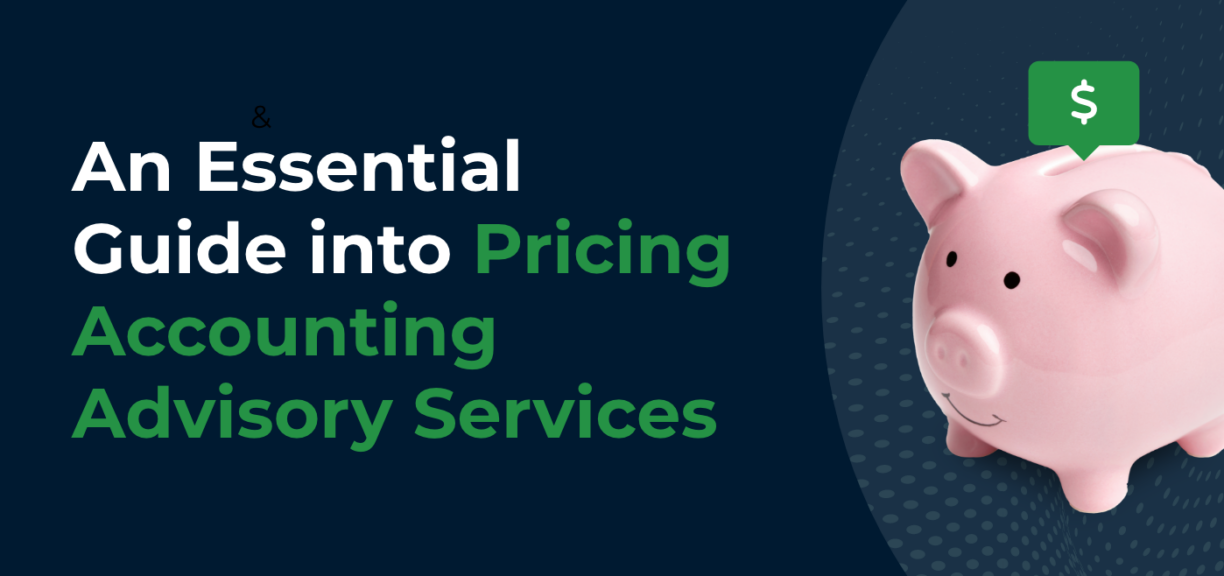An Essential Guide to Pricing Accounting Advisory Services
Author: Financial Cents
In this article
As a firm owner, you’ve made the exciting decision to offer accounting advisory services. But now, the inevitable question arises: how do you price them? Don’t worry, you’re not alone in this struggle.
Pricing in this industry extends beyond numbers. It reflects the unique value you bring to clients as a trusted advisor, guiding them toward financial success.
If you’re new to the field and unsure of where to begin, you can learn about accounting advisory services, and how to design and offer them as an accountant before diving into the intricacies of pricing these services, which will be the focus of this article.
Understanding the Value Proposition
The true value of accounting advisory services goes beyond just completing tasks. It’s about proactively helping businesses achieve their financial goals. Instead of just looking at the past, you provide insights into the future, identify problems, and create strategies for success. This forward-thinking approach helps protect your client’s interests and ensures their financial well-being.
When it comes to understanding what value means to clients, it depends on which perspective you’re looking at it from. If you’re looking at what you value as a firm owner, then you’re going to consider time, cost, and profit margin. However, if you’re looking at it from the perspective of your clients, then what they value is your expertise, your years of experience, your way of working with clients. And those things are more important than what you do."
Loren FogelmanA clear understanding of the value that you or your firm offers will inform your pricing strategy. This value can be quantified by measuring the tangible benefits you bring to the table (years of experience in your niche, wealth of knowledge, public recognition, the caliber of clients, etc) and the intangible value (long-term relationship with clients, peace of mind, trust in your services, etc).
With this, you can justify your pricing structure – whether hourly, fixed, value-based, or retainers – and demonstrate the return on investment that clients will receive by hiring you.
Factors Influencing Pricing in Accounting Advisory Services
Setting the right price for accounting advisory services is a nuanced process, requiring careful consideration of factors that impact both the value delivered and the cost of service delivery. Let’s discuss these factors in detail.
Scope and Complexity of Services
The breadth and depth of services you offer significantly impact your pricing strategy. The more complex and specialized your services are, the higher your price point will be. This is because complex services require specialized expertise, dedicated resources, and often sophisticated technology, all of which contribute to the cost of delivering the service.
Client Requirements
Setting the price for accounting advisory service isn’t just about the time it takes. It also depends on what the client needs – like how quickly the client needs the service, how much they’re willing to spend, their size, and what industry they’re in.
For instance, some companies need help with complex tasks like mergers and acquisitions or forensic accounting, that require specialized knowledge and resources. These companies will pay more for these services than a small business that just needs help with basic bookkeeping.
Market Demand
High market demand for accounting advisory services indicates a strong need for these services in the market. Research suggests that the market is expected to reach $127.320 billion by 2028. This increased need translates into a higher willingness to pay among clients.
When demand outstrips supply, clients are more likely to accept higher prices, allowing advisors to potentially charge premium rates. This can be seen in industries experiencing rapid growth or facing complex financial challenges, where the demand for expert advice is high.
Competitive Landscape
Market competition plays a crucial role in determining acceptable pricing for clients. As competition increases, firms may need to lower their prices to attract new clients and retain existing ones.
While maintaining profitability is crucial, charging too much might scare clients away, but charging too little might make them think you’re not very good. To find the sweet spot, you need to see what CPAs in your field charge for similar services. This helps you set a price that’s both fair for you and attractive to clients.
Expertise and Experience
The more years of experience you have in accounting, the higher your fees can be. This is because you’ve learned a lot and can handle tough situations better than someone with less experience. If you specialize in a specific industry, like healthcare or tech, you can also charge more than someone who doesn’t. This is because you know more about that specific industry and can help businesses in that field better.
Also, the size of your team and the types of experts on it can also affect your pricing. If you have a large team with lots of specialists, your fees will likely be higher than if you’re a solo act.
Pricing Models
Your choice of pricing model significantly affects how you price your accounting advisory services. It affects how much you charge, how you build relationships with your clients, and even how you manage your workload.

Different pricing models include:
- Hourly billing: charging for the time spent on a project
- Value-based pricing: basing fees on the specific value delivered to the client
- Retainer agreements: charging a fixed monthly fee for a predetermined set of services
- Subscription models: offering tiered access to services for a monthly fee
- Project-based pricing: charging a fixed fee for a specific project
Recommended Resource
Download: Playbook: How to Price Accounting and Bookkeeping Services for Ultimate Profitability
Different Pricing Models in Accounting Advisory Services
When it comes to choosing a pricing model for accounting advisory services, It’s not a one-size-fits-all approach, and the ideal model for your firm will depend on various factors.
Hourly Rates
For many years, charging by the hour has been the go-to way for accounting firms to price their advisory services. It’s easy for both clients and firms to understand and calculate, making it a transparent approach.
One of the biggest advantages of hourly rates is their flexibility. Fees can be adjusted based on the specific needs and complexity of each client’s situation. This makes it a good choice for handling diverse projects with different scopes and time requirements.
For smaller or simpler projects, hourly rates can be fairer than other models like fixed fees. This ensures that the firm is compensated for the time they actually spend on the project.
While it may be advantageous to charge hourly rates for accounting advisory services, it’s not always the best fit.
As Loren Fogelman of Business Success Solution says
With an hourly rate, you’re getting paid after you’ve already done the work. It positions your service as a commodity and overlooks your expertise because it prioritizes time over knowledge"
If you use hourly based and intend to increase your fees soon, you should read our accounting price increase letter guide (+ free template)
Project-Based Pricing
Project-based pricing, also known as fixed-fee pricing, takes the guesswork out of pricing your services. You charge a single fee for an entire project, agreed upon beforehand, based on a clear list of what you’ll deliver.
As Loren Fogelman says
this is when you charge a flat fee based on an agreed scope of work. Even though there might be some adjustments to the scope of work from time to time, for the most part, it stays steady.
Many clients prefer this model of pricing because it allows them to accurately budget for the project and allocate resources. They are also encouraged to focus on the overall value delivered by the project rather than micromanaging the time spent by the accounting firm.
For instance, if a potential investor requires due diligence services for a company acquisition. Your accounting firm can agree upon a fixed fee for reviewing financial statements, identifying potential risks, and providing valuation estimates.
A fixed-rate helps you become more profitable as you go. It incentivizes efficiency and you get paid before doing the work. As a result, you’re no longer chasing money."
Loren Fogelman, Founder, Business Success SolutionHowever, this pricing model also has its drawbacks.
If you set the price too low for a complex project, your firm might lose money. This can happen if you’re unsure of your services’ worth or are afraid of losing the client to a competitor. Also, unexpected delays or changes requested by the client can quickly push the project beyond its initial budget. This can lead to headaches for both you and your client.
Retainers
Retainer agreements are like a subscription for accounting advisory services. You pay a fixed monthly fee and get access to a set of services from your accounting firm whenever you need them. This is good for both the client and the firm: the client gets predictable costs and access to expert help, and the firm gets a predictable income stream.

For instance, a retainer could include quarterly or annual tax planning consultations, as well as support with tax preparation and filing.
One downside of retainer agreements is that clients might not use all the services they’ve paid for. This can lead to lost revenue for your firm and frustration for the client since they’re essentially paying for something they’re not using.
Another potential issue is “scope creep.” This happens when the agreed scope of work in the retainer agreement isn’t clear enough, and the client ends up asking for additional services that weren’t originally included. This can put a strain on your resources and lead to disagreements about what’s covered under the retainer agreement.
Value-Based Pricing
Value-based pricing as an accounting pricing model focuses on the specific value delivered to the client rather than the time spent or the cost incurred by the firm.
A survey by AICPA found that more and more firms are charging based on the value they deliver to clients instead of just their hourly rate. This means they focus on what the client gets out of the service, rather than just the hours spent working on it.
When figuring out your prices, it’s not all about the numbers. You need to show your clients how valuable your services are.
Mark Wickersham, a seasoned accountant and author who discussed how to implement value-based pricing says
Coming up with the price is a tiny part of the process, there are so many other things, that we have to understand, like how do we create value and how do we communicate the value of what we do, so the client sees that value and understands it"
The challenge with value-pricing is that most clients do not know the worth of your services. It is up to you to communicate the value of your services to them.
How do you do this?
Mark Wickersham suggests a pricing approach called “Menu Pricing.” This involves offering your clients three different options for the same service, each with a separate price. This way, your clients can choose the option they find most valuable for their needs.
Value pricing is about setting a price based on the value to the customer, not based on how many hours something takes. It sounds really simple but it is difficult to implement in the real world"
Mark WickershamPractical Strategies For Optimizing Pricing Structures In Accounting Advisory Services
Know Your Value Proposition
Clearly define the unique value you offer clients. What sets you apart from competitors? Quantify the tangible benefits (e.g., cost savings, increased profitability) and intangible benefits (e.g., peace of mind, strategic guidance) you deliver.
This clarity empowers you to communicate your value effectively and justify your pricing strategy to potential clients.
An example could be “We help small businesses achieve financial stability and growth through personalized accounting solutions and strategic financial guidance.”
Understand Your Market
Your clients have unique needs and budgets, so skipping proper market research before setting your prices would be a mistake. Research helps you understand their needs, identify industry trends, and quantify the value you offer based on real data.
Talk directly to your clients through surveys and interviews. Ask about their needs, struggles, and budget limitations. This valuable feedback will help you see how they perceive value and develop pricing models that truly serve them.
Once you have the research results, turn them into concrete actions for optimizing your pricing structure. This could involve creating new service packages, using value-based pricing models, or adjusting your pricing tiers to better match client expectations.
Analyze the Competition
To make sure your prices are both competitive and profitable, it’s important to understand what your competitors are charging. Take a close look at their websites, marketing materials, and industry publications to see what services they offer and how much they charge. This gives you a good idea of where your prices stand compared to theirs.
However, don’t just copy their prices. Focus on offering unique value to your clients that justifies your pricing strategy and makes you stand out from the crowd. This way, you can attract more clients and keep your business growing.
Set Competitive Yet Profitable Pricing
Now that you understand your target audience and competitor prices, it’s time to create your own pricing plan. Remember, there’s no single perfect plan. You can use industry standards as a starting point, but your ideal plan may be different. You can even combine ideas from existing plans or create something entirely new. The most important thing is that your pricing plan helps you make a profit.
Take Brandon Hall’s experience as an example. Initially, his subscription model for tax returns placed a significant burden on his working capital, requiring him to cover upfront labor costs. However, his vision led him to explore alternative models where clients shared the financial responsibility. This eventually led to a 50/50 split, significantly alleviating the pressure on his own finances.
Recommended Resource
Playbook: How to Build a 7 Figure Firm Through Advisory Services
Test, Measure & Adapt
As your business grows and changes, your pricing needs to change too. To stay ahead of the game and keep things relevant, it’s a good idea to try out new pricing methods with just a few clients first. This way, you can see how it works, get feedback, and make any adjustments before changing things for everyone.
Once you’ve tried the new pricing model with a small group, you can look at the results and see if it worked. Did it bring in the money you wanted? Did your clients like it? Based on what you learn, you can then decide to keep the new pricing, change it a bit, or even completely scrap it.
Just remember, your pricing should always be competitive and reflect the value you offer to your clients.
Addressing Client Expectations
Client expectations play a pivotal role in shaping effective pricing strategies for accounting advisory services. Understanding what clients expect and aligning your pricing models with those expectations is crucial for building trust, securing long-term relationships, and ultimately achieving success.
- Value-Driven Mindset:
Clients don’t just pay you for your time or skills. They’re actually investing in the clear and measurable benefits you can provide.
Loren Fogelman says that
he first thing to recognize is that you’re more likely to have clients see the value of moving forward at a new rate when you connect to the value that you offer. So you need to connect to your own value first before you can expect them to see the value of moving forward with you in that direction"
- Be Transparent & Fair:
Clients want to know exactly what they’re paying for. They like to see how the price is calculated, what services are included, and how their money will benefit them. Don’t just tell them you need to raise prices because your costs are going up. They don’t care about that. Focus on the value they’ll receive for their investment.
- Flexibility and Customization:
Forget one-size-fits-all solutions! Clients want pricing that bends to their needs and budgets. Loren suggests ditching fixed fees and hourly rates in favor of packages. This gives clients more flexibility and shows you prioritize their best interests, not just your own.
- Communication and Responsiveness:
It’s important to keep your clients informed throughout the process. Talk to them before you raise your prices after you’ve discussed the changes, and finally, when the new prices take effect. This way, they’ll be in the loop and won’t be surprised by any changes.
Gain Valuable Insights with Financial Cents
Sure, accounting software makes life easier, but to really unlock the best prices for your services, you need powerful technology. While basic accounting software helps with routine tasks, Financial Cents takes things a step further by improving your accounting workflow so you can get work done and hit your deadlines.
Our dedicated software also reveals how profitable each client is for your firm using information such as how much time you spend on their work compared to how much money you charge. This knowledge empowers you to price your services accurately, ensuring both client satisfaction and your own profitability.
Use Financial Cents Accounting Practice Management software to scale your accounting firm.
Instantly download this blog article as a PDF
Download free workflow templates
Get all the checklist templates you need to streamline and scale your accounting firm!
Subscribe to Newsletter
We're talking high-value articles, expert interviews, actionable guides, and events.

The 5 Best Avii Workspace Alternatives for Modern Firms
If, for whatever reason, Avii does not meet your long-term workflow needs, this review of the best Avii workspace alternatives should help…
May 08, 2024

The 6 Best Canopy Alternatives to Consider in 2024
Wondering if Canopy is the right fit for your accounting firm? Discover 6 canopy alternatives to streamline your workflow and boost efficiency.
May 08, 2024
